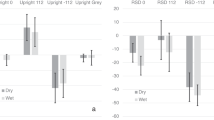Abstract
This article describes the results of the “ellipses” experiment conducted during the second French-Soviet spaceflight (project Aragatz). The realization of oriented motor tasks, on the basis of internal body representation and without visual feedback, was chosen as a paradigm for studying the determinants of spatial orientation under weightlessness. The process of drawing ellipses in the air, using arm movements with axes parallel or perpendicular to the longitudinal body axis, was studied under normal gravity and in weightlessness, and recorded using a video computer motion-analyzing system (Kinesigraph). On Earth, the experiments were performed in standing and lying positions, and in flight, in the erect position with the feet fixed to the floor. In general, performance of the task in microgravity was not disturbed. Under conditions of spaceflight, the longitudinal ellipse was inclined forward in accordance with the inclination of the whole body relative to the fixed feet. On Earth, the angle between the long axes of longitudinal and transverse ellipses deviated from 90° by 20–30°. The same deviation persisted under microgravity conditions. The distinctive features of ellipses traced by individual subjects were also preserved. It is concluded that an egocentric reference system ensures normal performance of sensorimotor tasks in the absence of a gravitational reference.
Similar content being viewed by others
References
Clement G, Gurfinkel VS, Lestienne F, Lipshits MI, Popov KE (1984) Adaptation of postural control to weightlessness. Exp Brain Res 57:61–71
Friederici AD, Levelt WLM (1990) Spatial reference in weightlessness: perceptual factors and mental representation. Percept Psychophysics 47:253–266
Graybiel A, Kellog RS (1967) The inversion illusion and its probable dependence on otolith function. Aerospace Med 38:1099–1103
Graybiel A, Miller EF, Billingham J, Waite R, Berry CA, Dietlein LF (1967) Vestibular experiments in Gemini Flight Y and YII. Aerospace Med 38:360–370
Homick JL, Miller EF (1975) Apollo flight crew vestibular assessment. In: Johnston RS, Deitlein LF (eds) Biomedical results of Apollo. NASA SP 368
Matsnev EI, Yakovleva IY, Tarasov IK, Alekseev VN, Kornilova LN, Mattev AD, Gorgiladze GI (1983) Space motion sickness: phenomenology, countermeasures, and mechanisms. Aviat Space Env 54:312–317
Miller EF, Graybiel A (1973) Experiment M-131. Human otolith function. Aerospace Med 44:593–608
Mittelstaedt H (1983) A new solution to the problem of the subjective vertical. Naturwissenschaften 70:272–281
Mittelstaedt H, Glasauer S (1990) Determinants of spatial orientation in weightlessness. In: Proceedings of the fourth European symposium on life research in space, Trieste, Italy. ESA SP-307, pp 153–155
Mittelstaedt H, Glasauer G, Gralla G, Mittelstaedt ML (1989) How to explain a constant subjective vertical at constant high speed rotation about an earth-horizontal axis. Acta Otolaryngol 468:295–299
Oman CM, Lichtenberg BK, Money KE, McCoy RK (1986) Space motion sickness: symptoms, stimuli, and predictability. Exp Brain Res 64:316–334
Roll JP, Poll R (1988) Extraocular proprioception and body postural references. In: Gurfinkel VS, Ioffe ME, Massion J, Roll JP (eds) Stance and motion. Facts and concepts. Plenum Press, New York, pp 23–36
Schöne H (1964) On the role of gravity in human space orientation. Aerospace Med 8:764–772
Schöne H, Udo de Haes H (1971) Space orientation in humans with special reference to the interaction of vestibular, somaesthetic and visual inputs. In: Drischel H, Tiedt N (eds) Biokybernetik III. VEB Gustav Fischer Verlag, Jena, pp 172–191
Soechting JF, Lacquanity F, Terzuolo CA (1986) Coordination of arm movements in three-dimensional space. Sensorimotor mapping during drawing movement. Neuroscience 17:295–311
Young LR, Oman CM, Watt DGD, Money KE, Lichtenberg BK (1984) Spatial orientation in weightlessness and readaptation to earth's gravity. Science 225:205–208
Yuganov EM, Kopanev BI (1975) Physiology of the human sensory system in space flight. In: Calvin M, Gazenko O (eds) Foundations of space biology and medicine, vol II, book 2, NASA/ USSR Academy of Sciences, Washington DC, pp 173–197
Author information
Authors and Affiliations
Rights and permissions
About this article
Cite this article
Gurfinkel, V.S., Lestienne, F., Levik, Y.S. et al. Egocentric references and human spatial orientation in microgravity. Exp Brain Res 95, 343–348 (1993). https://doi.org/10.1007/BF00229792
Received:
Accepted:
Issue Date:
DOI: https://doi.org/10.1007/BF00229792




